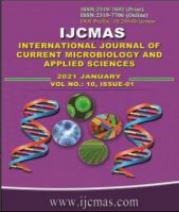


 National Academy of Agricultural Sciences (NAAS)
National Academy of Agricultural Sciences (NAAS)

|
PRINT ISSN : 2319-7692
Online ISSN : 2319-7706 Issues : 12 per year Publisher : Excellent Publishers Email : editorijcmas@gmail.com / submit@ijcmas.com Editor-in-chief: Dr.M.Prakash Index Copernicus ICV 2018: 95.39 NAAS RATING 2020: 5.38 |
Three exotic and six indigenous almond genotypes were investigated for their floral biology at Dryland Agriculture Research Station, SKUAST-Kashmir for two consecutive years. There was considerable overlapping of bloom among cultivars. Early pink bud (20th February), advanced pink bud (5th March), initial bloom (8th March) was observed in KD-05 whereas full bloom (14th March), initial petal fall (16th March), complete petal fall (18th March). KD-05 was earliest in early pink bud (22nd February), advanced pink bud (5th March), initial bloom (7th March), full bloom (12th March), initial petal fall (15th March) and complete petal fall (19th March) in the second year of study. Primorskij and Pranyaj was late in all the floral phenology characters studied. Duration of bloom ranged from four days in Pranyaj, Mukhdoom, KD-06 and Shalimar to nine days in Primorskij and Merced. Stigma receptivity was 100 per cent on the day of anthesis, one day after and one day before of the anthesis among all the genotypes, however, optimum stigma receptivity was recorded for duration of four days in all the genotypes. Maximum pollen germination of 96.0 per cent and 90.0 per cent was observed for Primorskij and Pranyaj in first and second year of study, respectively. Among all the genotypes studied Mukhdoom, Shalimar, KD-03, KD-05 and KD-06 were early bloomers whereas Pranyaj, Merced, Primorskij and Waris were late in flowering.
 |
 |
 |
 |
 |